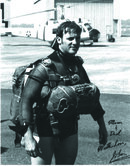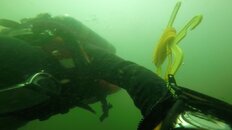I have several tapered thread cylinders.
So, the first problem they pose, is that you need a cylinder vise to remove and replace the valve. You can't just hit the wrench with a mallet the way you usually can with straight threads. Most LDSs, and most divers, don't have a cylinder vise. I don't, really, although I have been marginally successful improvising one using a sheet of rubber and some big stainless steel hose clamps.
Well, yes sorta a problem. For those of us with doubles, we don't need a cylinder vice, as we had the doubles bands and can band the cylinders together, then kneel on one while working on the other side's valve. We did this in the field when in the USAF dealing with our pararescue jump tanks. We had to take the center section off first, then reattach the bands and remove the valves in the tanks. It does take a rather large wrench to get them in and out though.
The second problem is that there is cumulative deformation of the threads every time you remove and replace the valve. Since brass is softer than steel, most (but not all) of the deformation is to the brass valve rather than the steel cylinder neck. You get maybe 5 or 8 or 10 fittings and then the valve is done. That means that if you're following the annual VIP rubric you're going to have to replace the valve after that many years. The steel deforms, too, and in the packaged gas industry they deal with that by using oversize valves that have the equivalent of 1, 2, 3, or 5 extra threads. Such valves aren't available in scuba configurations so you're stuck with a more limited cylinder lifespan. When tapered threads were in widespread use, there was just the hydro every 5 years and no annual VIP.
Well, again this is sorta true, but in my experience not much of a problem. The valves don't really deform if Teflon tape is used, as the tape itself provides some lubrication as the valve's threads are tightened. But you need to apply the Teflon tape correctly to make it work (see the explanation below). I'm looking at one of my old 1/2 inch tapered thread K-valves, which I used for about twenty years on an old set of PJ jump tanks (since decommissioned). It shows no deformation of the threads, in spite of my cinching them down really tight on the tank. These are "tapered threads" for a reason, and if there is any deformation, all that is necessary is to screw them down a bit more.
The third problem is that sometimes they leak, as opposed to tapered threads with an o-ring, which never leak without a good reason. I had a cylinder hydro'd and VIP'd and filled, and I got it home and put it away, and that weekend I went to use it and it was empty. I thought the shop had never filled it and we had an awkward moment when I brought it back to them and insisted that they fill it since the didn't do so before, and they adamantly insisted they had. I took it home and resealed it myself using a combination of teflon tape and paste pipe compound and transfilled it, and it was fine.
I know of no 1/2 inch valves with an O-ring that has tapered threads. When the change was made to an O-ring seal, the 1/2 inch valves (I'm pretty sure) went also to straight threads. This was necessitated by the need to seal the O-ring, and with tapered threads you may not get the valve set far enough down to seal the O-ring. Shortly thereafter, all the tanks went to 3/4 inch straight thread valves with O-rings. There were very few tanks made for a 1/2 inch valve with O-rings.
Now, concerning these valves leaking, usually that is because the Teflon tape is improperly applied. Each time I do it, I have to experiment to remember the sequence. The Teflon tape must be applied so that, as the valve is screwed in, the tape itself will also be bound, and not bunch up. Since the valve is being screwed in clockwise (a concept many school kids now don't know), we need to apply the Teflon tape in a clockwise manner too, from the top to the bottom (toward the dip stick), and be pulled tight to seal the threads with at least two wraps (I think I usually use three wraps) around the threads). This is so that the tank's threads, when they first engage the Teflon tape, don't try to unwind them, but rather incorporate the Teflon tape into the thread.
I have never used paste pipe compound on my valves, as that makes the valve very difficult to remove.
The fourth problem is that some LDSs won't touch them. I've heard of LDSs that won't fill them, period. There are some who will fill them but won't VIP them. There are some that charge extra for VIP. Etc.
Very, very true. I have the only set of 1/2 inch tapered thread valves in my twin 42s (PJ Jump Tanks) that my LDS will fill, and the only reason the LDS tolerates me with this set is that I do all the work. This dive shop has gotten rid of all these old tanks from years ago. The reason, it's too much trouble to get the valve off, and back on, yearly just is you state.
And finally if you are going DIN as I am the only available tapered valves are expensive.
Ultimately you have to decide whether such cylinders are economical and meet your needs given the overall situation.
No question there. I'm using my 1/2 inch valves because the PJ tanks are very vintage, and worth keeping in operating condition. I love how they fit on my back with the old-style military harness, and behave in the water. The photo below shows me wearing these jump tanks while a Pararescuemen with the 304th Aerospace Rescue and Recovery Squadron in about 1975.
The second photo is of my current PJ tanks being used this summer when
I observed and videoed lampreys spawing in the Clackamas River. I also was using a Healthways hybrid Scuba double hose regulator (Gold Label innards with an original Healthways Scuba box set).
SeaRat





